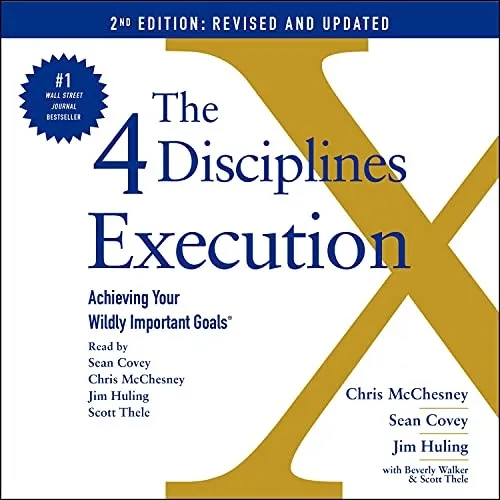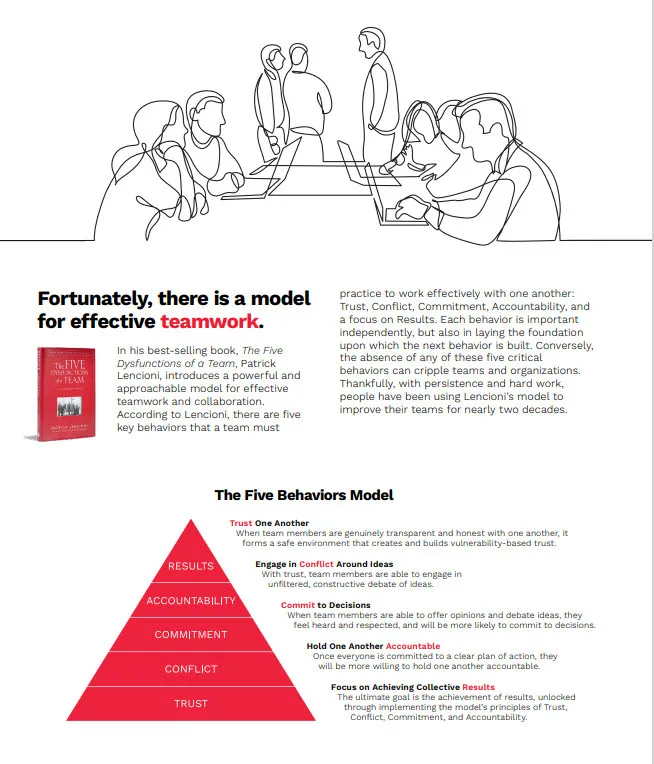When Execution Matters Most
In This Issue
- When Execution Matters Most
- The 4 Disciplines of Execution
- Five Behaviors® Team Development Process
- Become a Five Behaviors® Certified Practitioner

When Execution Matters Most: Are You Making This Common Leadership Mistake?
In a recent article in Human Resource Executive, Paul Walker, CEO of Franklin Covey said, “One common leadership mistake in response to economic volatility is focusing on short-term survival, which often means putting revenue first and people second.”
However, Walker believes the most effective leaders keep an eye on the long term, balancing immediate results with investment in the people working to achieve those results—which also positions their organizations for a stronger recovery. He recommends the principles found in the best-selling book, The 4 Disciplines of Execution (2012) which helps companies keep their execution strategy on point in any economic situation.
Here is an Overview of the 4 Disciplines
Discipline 1: Focus on the Wildly Important Goals (aka: WIGS)
This discipline is about focus. Without it, you will never get the results you want.
Discipline 2: Act on the Lead Measures
This is the discipline of leverage. Regardless of your strategy, your progress and ultimately your success will be based on two kinds of measures: lag and lead.
Lag measures are historical indicators of performance and must be expressed in terms of from X to Y by when.
Lead measures must be both predictive of achieving the WIG and influenceable by the team. Acting on lead measures is considered one of the little-known secrets of execution.
Discipline 3: Keep a Compelling Scoreboard
This is the discipline of engagement. Gallop surveys continue to indicate that levels of employee emotional engagement remain unacceptably low. The ideal solution is to have a scoreboard that is so simple that team members can instantly determine if they are winning or losing.
Discipline 4: Create a Cadence of Accountability
This discipline is where execution really happens. Team members must be able to hold each other accountable regularly and rhythmically.
The Five Behaviors® Model of Effective Teamwork
In my experience, effectively implementing The Four Disciplines of Execution requires what best-selling author Patrick Lencioni calls The Five Behaviors of a Cohesive [high performing] team.
Note The Five Behaviors hierarchy illustrated in the model below and how well it integrates and reinforces the four disciplines.

The Resources To Assure Your Teams Can Achieve Their Wildly Important Goals
In the 4 Disciplines model, results—achieving your WIGS is the end game. In the Five Behaviors model, trust is the starting point—at the bottom and systematically building toward the top to achieve collective results.
A Culture of Trust
Paul Walker points out, “A culture of trust is especially important during difficult times because it helps teams feel safe, connected, and motivated. It empowers people to bring their best selves and ideas to work, fostering greater innovation, productivity, and business results. The more trust that exists within a team, the better they can execute on your most important goals.”
This is where the Five Behaviors model comes in. Imagine the positive impact on results (WIGS) when you build teams (intact and remote) to practice the 5 Behaviors.
Building teams in today’s work environment is more complex than ever. Yet it’s teamwork that remains the ultimate competitive advantage. Combined with The 4 Disciplines of Execution You can be assured of achieving your Wildly Important Goals (WIGS).
Click on the Link Below to View a short video about the Five Behaviors Team Development Process.
Click here to learn more about the 5 Behaviors Team Development Process
Learn How to Implement the Five Behaviors Yourself
As a Five Behaviors® Certified Practitioner, you’ll have the power to create a culture of teamwork, with high-performing teams that elevate the entire organization and drive results.
The Five Behaviors® Certification prepares practitioners to deliver engaging and impactful Five Behaviors® learning experiences that help build cohesive teams.
Click the Link Below to Learn How to Become a Five Behaviors® Certified Practitioner.
Click here to learn more about Team Development Certification
